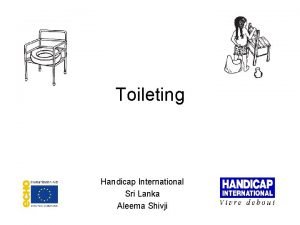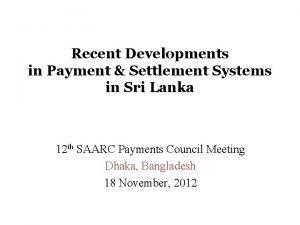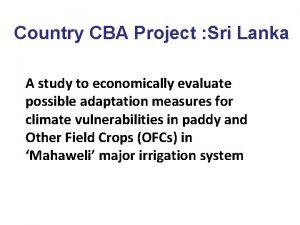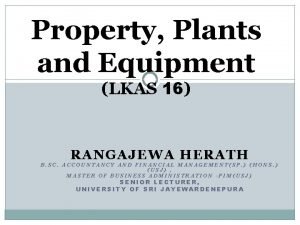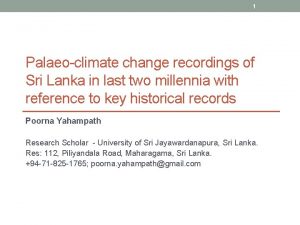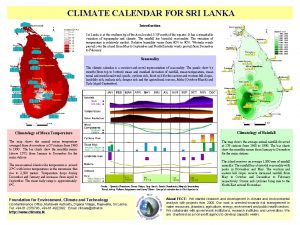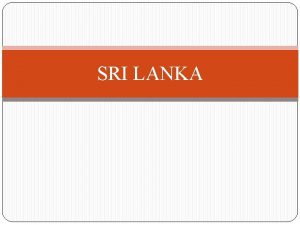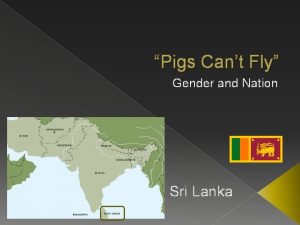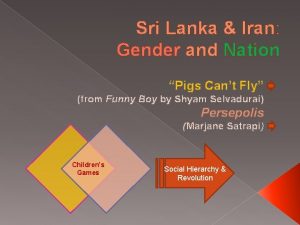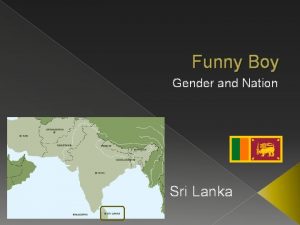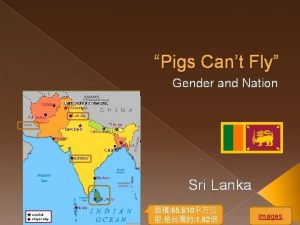THE GENDER WAGE GAP IN SRI LANKA A

















![Objective 5 ¢ use a recently developed methodology [Yun 2003] to perform a detailed Objective 5 ¢ use a recently developed methodology [Yun 2003] to perform a detailed](https://slidetodoc.com/presentation_image_h2/97b2d1ae37c4ea332adf764d2d698536/image-18.jpg)




- Slides: 22

THE GENDER WAGE GAP IN SRI LANKA A revised proposal submitted to the PEP research network Dileni Gunewardena University of Peradeniya, Sri Lanka

Primary objective of the study To better understand the factors underlying the gender wage gap in Sri Lanka

Gender wage gap n n The gap between average male and female wages In practically every country in the world, women earn less on average than men (World Bank 2001) Teaplucker, Matale, --April 2005 Simon Perera, labourer, Colombo’s main wholesale market. --Daily News/REUTERS 2 nd April 2003

Why Sri Lanka? n o o o Sri Lanka’s performance on gender rights and outcomes is good High GDI, GEM not as good Low maternal mortality Parity in primary school enrolment Higher female secondary school enrolment Gender equality a fundamental right (1978 constitution) Equality of wages legislated

Why Sri Lanka? n n Sri Lanka is in many senses a model— where many countries would like to be. Therefore this study hopes to provide answers to questions like How did Sri Lanka get there? What factors helped? When Sri Lanka “got there” who was left behind, and why?

Explanations for the existence of a gender wage gap n n n women have fewer of the productive characteristics (education, training, skills, experience) that earn higher wages (Human capital theory) women are discriminated in the labour market in the sense that they are paid less for the same productive characteristics (eg. equally educated men and women with the same amount of experience will be paid differently)—residual definition women choose, or are forced into lower-paying occupations (occupational choice/segregation) they are less likely to be hired into public sector employment where parity is observed, and women are a greater proportion of the labour force in economically less developed (rural) areas.

Earnings Function ln. Wij = Xij bj + eij, individual i, group j Wij = individual earnings (wages) Xij = individual characteristics bj = vector of parameters eij = zero mean error term, uncorrelated with Xij Blinder-Oaxaca Decomposition ln. W*m- ln. W*f = bm(X*m -X*f ) + X*f(bm - bf ) [Total difference] [Characteristics] [Returns to characteristics] ln. W* = predicted mean (log) earnings (wages) X* = mean characteristics of males (m) and females ln. W*m- ln. W*e = bf(X*m -X*f ) + X*m(bm - bf )

What do we know about the gender wage gap in Sri Lanka? n n n There is no consistent gender wage gap series for Sri Lanka (CEDAW 2002) Existing studies (Aturupane 1997, Ajwad and Kurukulasuriya 2002, Gunewardena 2002) following standard methodology (Blinder 1973, Oaxaca 1973) indicate discrimination, rather than differences in productive characteristics, account for a large proportion (all) of the gender wage gap. The size of the wage gap differs by ethnicity (Ajwad and Kurukulasuriya 2002) and occupation (Chandrasena 2005)

What do we need to know? 1. n What has been happening to the gender wage gap over time? Specifically, what trends in the wage gap can be observed during a time when important shifts in female labour supply and demand can be observed? Importance: Time period when female LFP has been increasing—demand (export industries) driven? —can facilitate further research—esp. on the interactions between trade, growth and gender inequality—and input into policy.

Objective 1 ¢ to construct a gender wage gap series for Sri Lanka using pooled individual records from quarterly labour force survey data (QLFS) for the past 9 years, which will be disaggregated by occupation, industry, location and educational level.

What do we need to know? n n What contributes more to the overall gender wage gap? Occupational segregation, or gender differentials within occupations? Importance: understand the contribution of occupational segregation to the wage gap, how this has changed in the last 9 years and provide the basis for further research and policy.

Objective 2 ¢ perform a (occupational structure) decomposition exercise to divide the overall gender gap into a portion explained by the distributional and pay differences across occupations and a portion due to distributional and pay differences within occupations, following Kidd and Shannon (1996).

What do we need to know? 2. n How have the determinants of earnings changed over the past decade, and how have these been different for men and women? Has “discrimination” increased or decreased? Importance: consistent comparison of how determinants (and decomposition into characteristics and “discrimination”) have changed over time. Useful for research and policy.

Objective 3 ¢ apply regression analysis to pooled individual records from selected years in this 9 year period to examine the determinants of male and female earnings, focusing on education, experience, occupational structure, sector of employment (public or private) and spatial location. Apply standard B-O decomposition.

What do we need to know? 3. n n How have the determinants of earnings been different for men and women in different parts of the earnings distribution? Does the extent to which discrimination accounts for the wage gap differ in different parts of the earnings distribution—is there a glass ceiling or a sticky floor? Importance: If there is a sticky floor, this means those most affected by gender discrimination are the poorest—influence labour market policy so wages at the bottom are more equal.

Objective 4 ¢ use quantile regression techniques to control for individual and job characteristics at different points of the distribution and calculate the part of the gap attributable to difference in returns to characteristics (“discrimination”).

What do we need to know? 4. n Where (in relation to which factor) is discrimination occurring more—or most? in relation to education, experience, occupation, sector of employment? Importance: understand which policy variables are most important, and how they should be influenced
![Objective 5 use a recently developed methodology Yun 2003 to perform a detailed Objective 5 ¢ use a recently developed methodology [Yun 2003] to perform a detailed](https://slidetodoc.com/presentation_image_h2/97b2d1ae37c4ea332adf764d2d698536/image-18.jpg)
Objective 5 ¢ use a recently developed methodology [Yun 2003] to perform a detailed decomposition of the gender wage gap in order to identify the specific contributions of education, experience, occupational structure, and public sector employment to the gender wage gap; and to identify within each of these categories, what proportion of the gap is due to “discrimination” vs. endowment differences.

Summary of Objectives For all years from 1996 -2004 (1) to construct a gender wage gap series for Sri Lanka (2) perform a decomposition exercise to divide the overall gender gap into within and across occupation components For selected years within this period (3) examine the determinants of male and female earnings, aggregated decomposition of the wage gap, and how they have changed over time (4) use quantile regression techniques to control for individual and job characteristics at different points of the distribution and calculate the part of the gap attributable to difference in returns to characteristics (5) to perform a detailed decomposition of the gender wage gap in order to identify the specific contributions of education, experience, occupational structure, and public sector employment to the gender wage gap

Summary of Objectives For all years from 1996 -2004 (1) to construct a gender wage gap series for Sri Lanka (2) perform a decomposition exercise to divide the overall gender gap into within and across occupation components For selected years within this period (3) examine the determinants of male and female earnings, aggregated decomposition of the wage gap, and how they have changed over time (4) use quantile regression techniques to control for individual and job characteristics at different points of the distribution and calculate the part of the gap attributable to difference in returns to characteristics (5) to perform a detailed decomposition of the gender wage gap in order to identify the specific contributions of education, experience, occupational structure, and public sector employment to the gender wage gap

Data sources n n Individual records (about 7000 observations per year) from the Quarterly Labour Force Surveys (QLFS) from 1996 to the latest completed year (2004) conducted by the Department of Census and Statistics, Sri Lanka (DCS-SL). Specifically o o Gender wage gap series and Kidd and Shannon decomposition for all years from 1996 -2004. Cross section analysis (OLS, quantile and Yun decomposition) for 3 separate years within this time period.

Thank you!
 Sri rama sri rama sri manoharama
Sri rama sri rama sri manoharama Aleema shivji
Aleema shivji Sri lanka tea board elevation average
Sri lanka tea board elevation average Finance commission of sri lanka
Finance commission of sri lanka Lanka settle system
Lanka settle system Sri lanka folk tales
Sri lanka folk tales Administrative structure of health service in sri lanka
Administrative structure of health service in sri lanka Apartment ownership law no 11 of 1973 sinhala
Apartment ownership law no 11 of 1973 sinhala Cba sri lanka
Cba sri lanka Sri lanka accounting standards
Sri lanka accounting standards Seismometer in sri lanka
Seismometer in sri lanka Tintin in sri lanka
Tintin in sri lanka Sachille atapattu
Sachille atapattu Shotokan karate sri lanka
Shotokan karate sri lanka Ecommerce website in sri lanka
Ecommerce website in sri lanka Sri lanka tsunami warning system
Sri lanka tsunami warning system Lkas
Lkas How to calculate vat in sri lanka
How to calculate vat in sri lanka Metric map sri lanka
Metric map sri lanka Collab sri lanka
Collab sri lanka Limitations of pqli
Limitations of pqli Northeast monsoon sri lanka
Northeast monsoon sri lanka English book grade 11
English book grade 11

